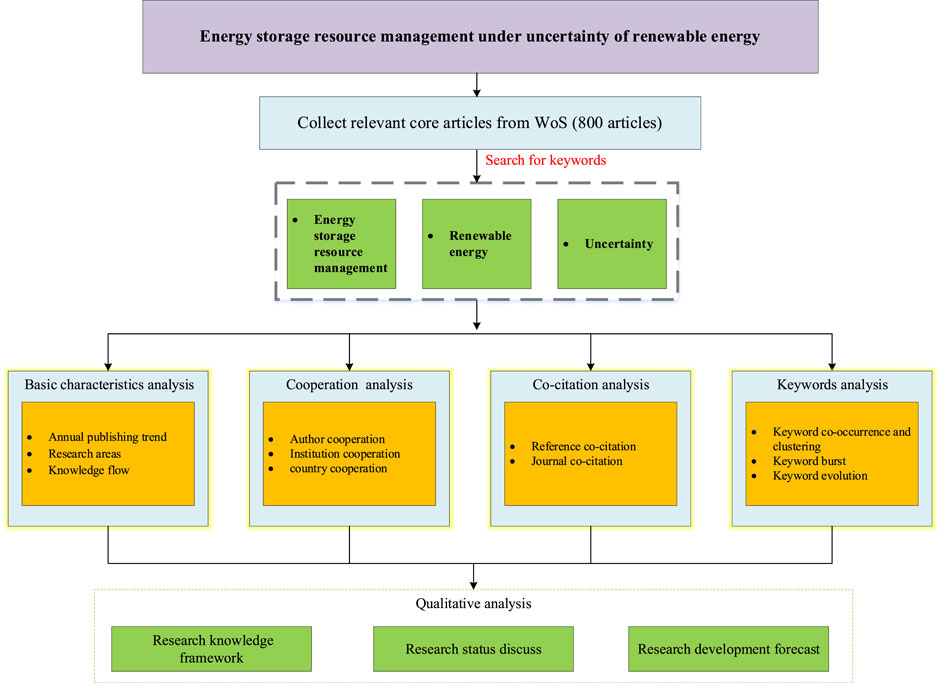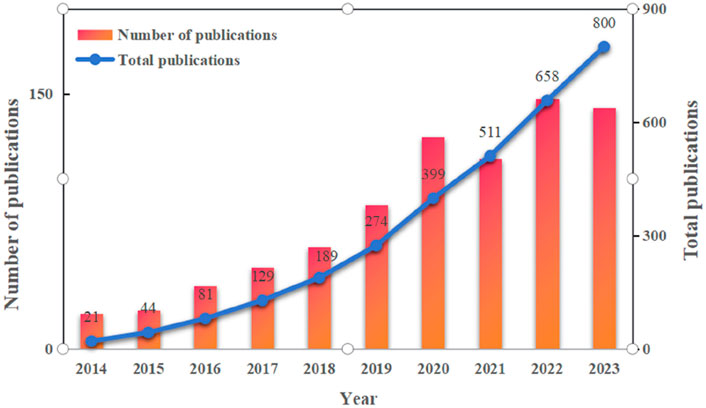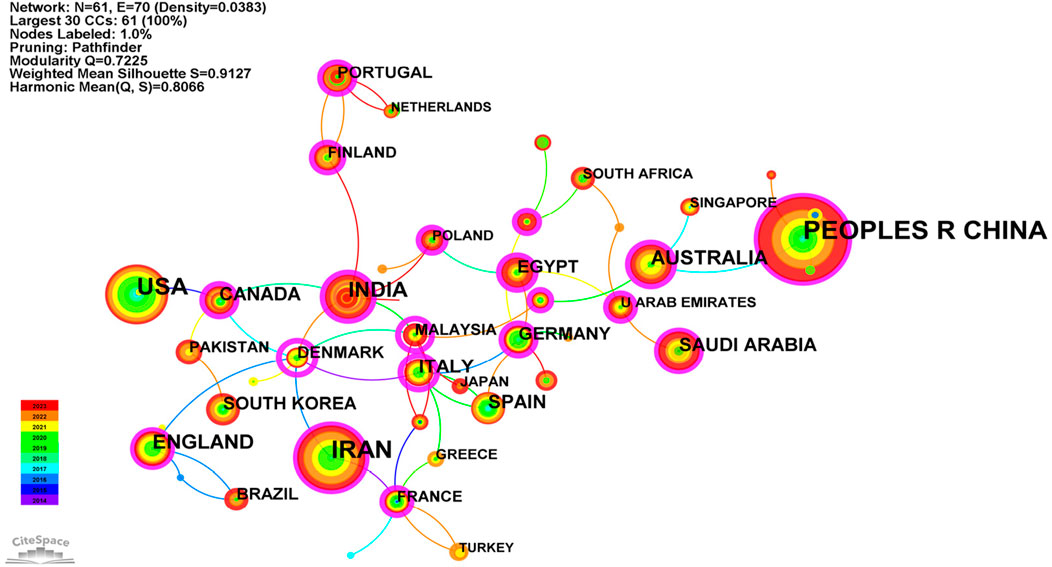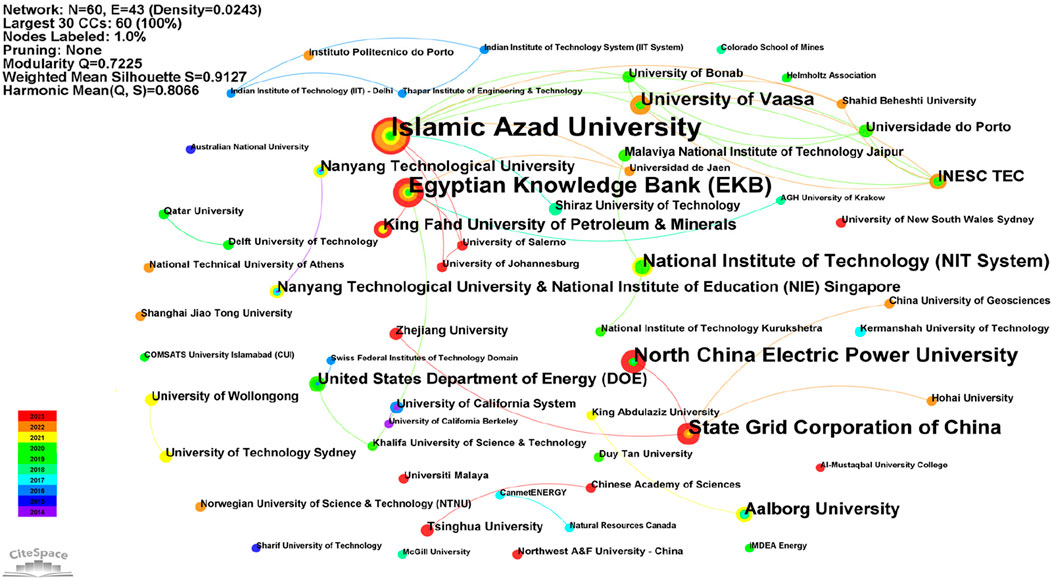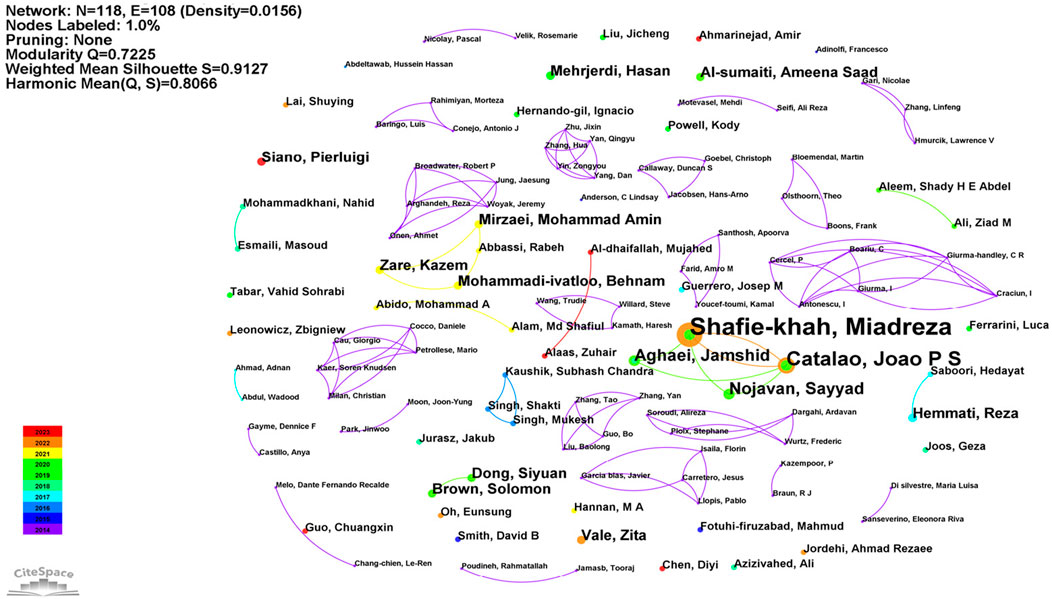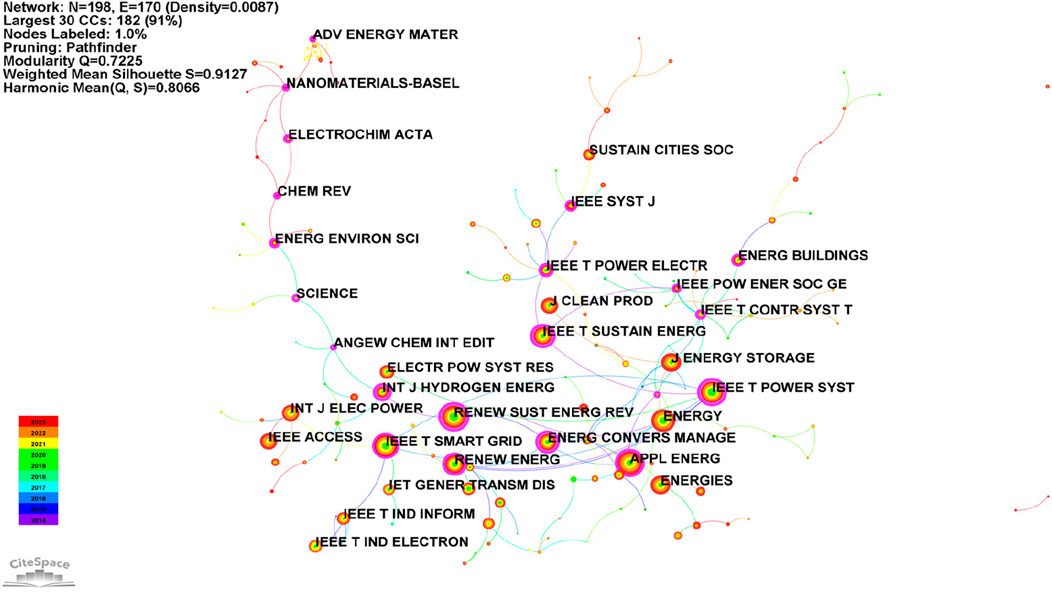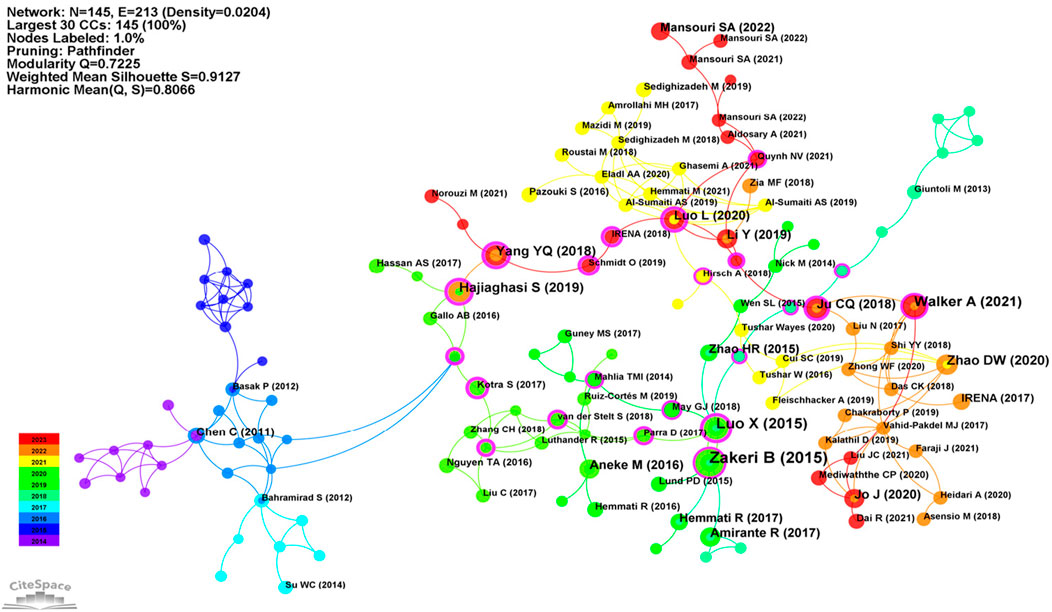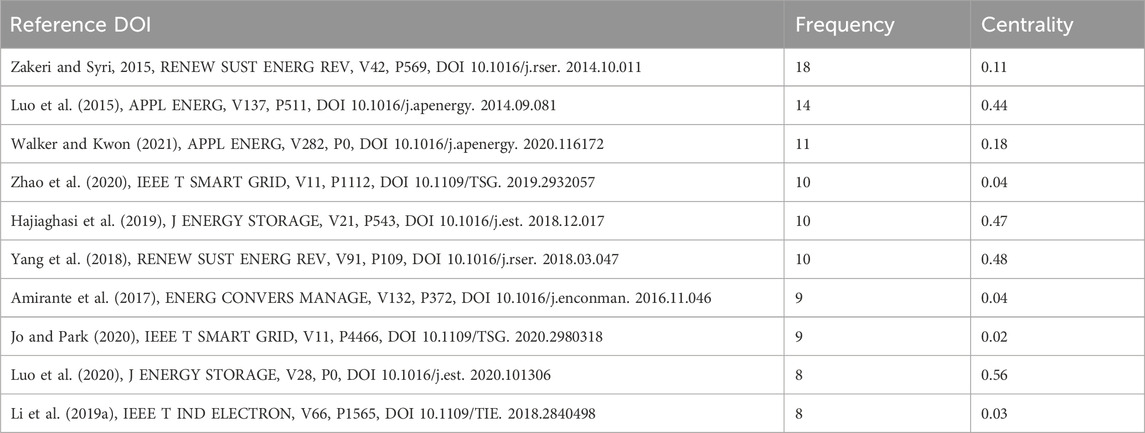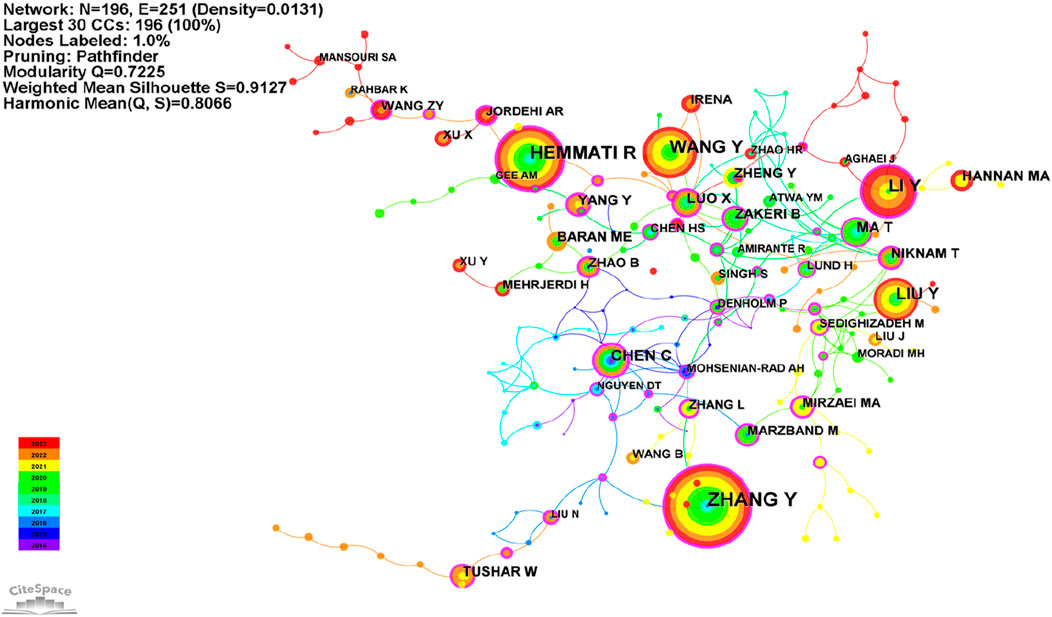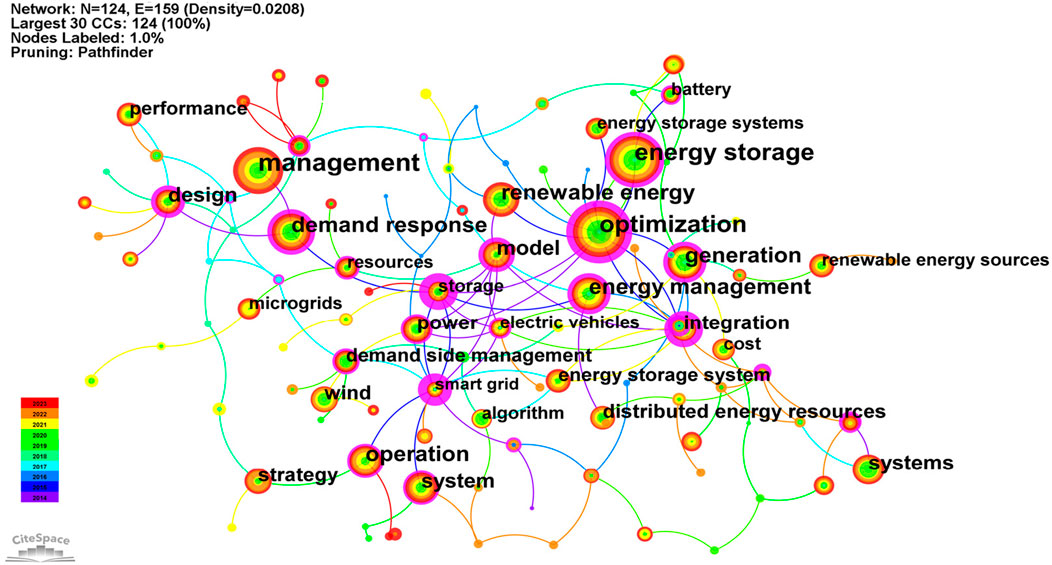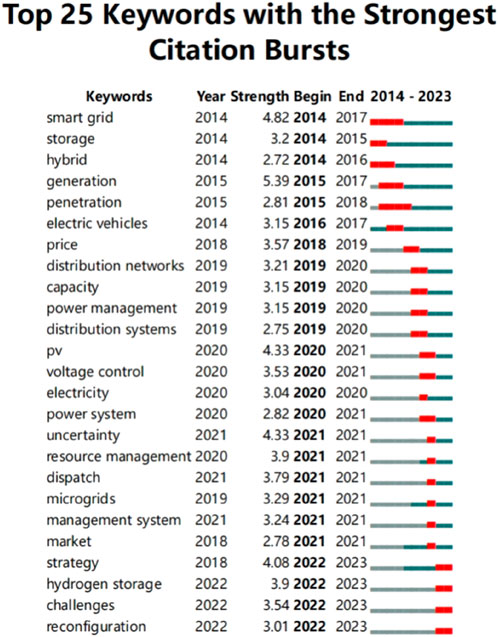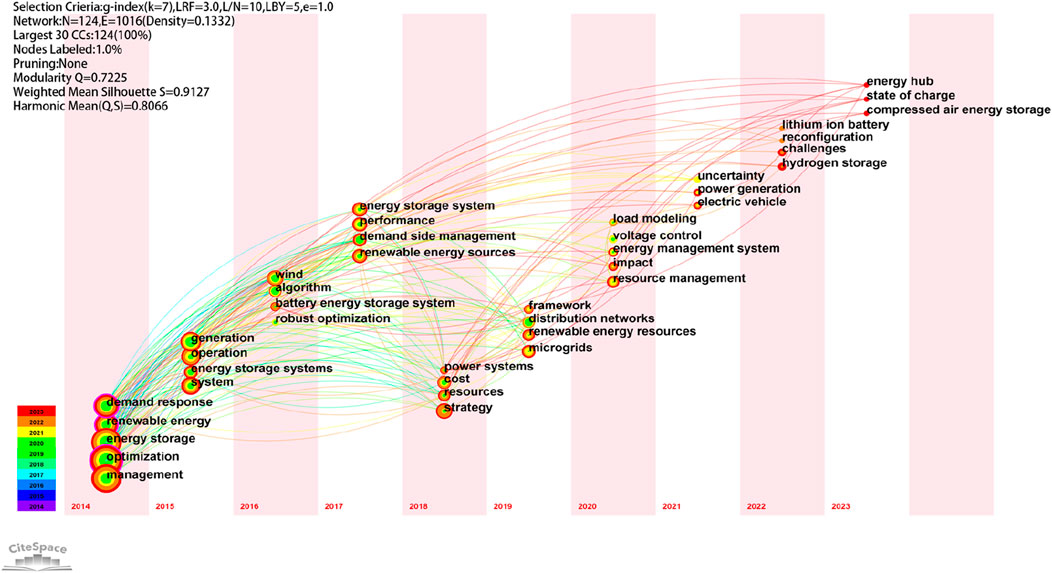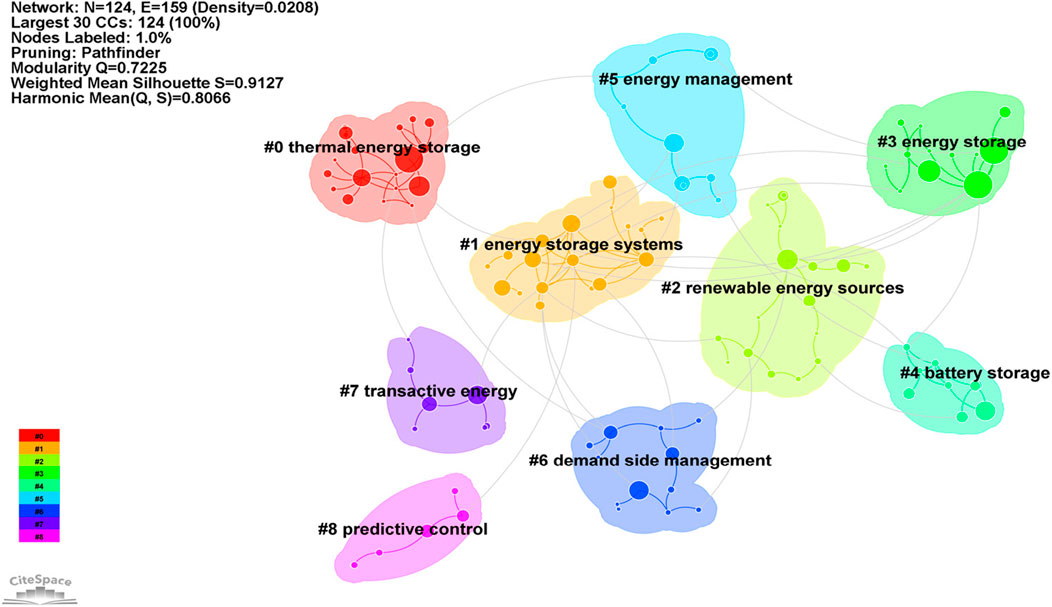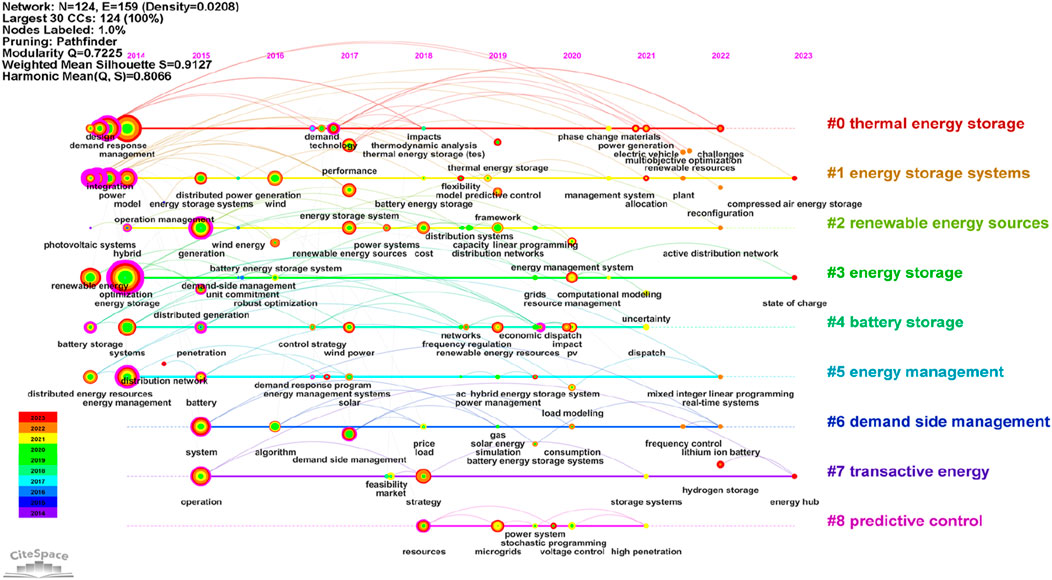- School of Management, Xi’an University of Science and Technology, Xi’an, China
The research on energy storage resource management is an important measure to cope with the present problem of uncertainty in the use of renewable energy, in order to explore the evolution of the research focus and future trend of energy storage resource management under the uncertainty of renewable energy, this paper adopts the method of bibliometric analysis, and conducts a visual analysis of the relevant 800 documents in the core collection of the Web of Science by using the CiteSpace to draw co-occurrence maps and analyze the collaborative networks of different countries/regions, institutions and authors in this field, and further conducted journal co-citation analysis, literature co-citation analysis and author co-citation analysis. The keyword co-occurrence, emergent analysis, and cluster co-occurrence analysis reveal the current research focus and trend in this field, and summarize and propose four future key focus directions: energy storage technology improvement, energy storage system integration, expansion of business models for energy storage resource management, and intelligent control of energy storage system, which provide new research paths for solving the problem of renewable energy uncertainty in the future.
1 Introduction
With the increasing impact of global climate change on the ecological environment, socio-economics, and human activities, the human society’s demand for renewable energy is increasing dramatically, the high variability of renewable energy availability and uncertainty in its prediction impede the matching of production and demand, in addition, the problem of uncertainty of renewable energy includes its inherent shortcomings such as stochasticity, intermittency, and uncontrollability, which will have a negative impact on the energy system’s stability, security and economy negatively (Byers and Botterud, 2020; Feng et al., 2020), which increases the difficulty of energy management. While energy storage resource management is an effective way to solve the renewable energy management challenges, energy storage systems can temporarily store energy, realize two-way energy flow, support the safe and stable operation of large-scale renewable energy access energy systems by peak peaking, stabilizing grid fluctuations, improving grid quality, delaying grid upgrades, and retaining energy (Lockley and Hippel, 2021). Therefore, storage of energy will enable the management of the energy generated, reducing the impact of forecasting errors by matching the output to the forecasted production.
In the study of energy storage resource management under renewable energy uncertainty, we found that conducting energy storage resource management can solve the problem for the following reasons.
First of all, energy storage resource management increases the stability of energy supply, the traditional power system is based on the one-to-one interaction of the way to establish, in order to meet the requirements of stability and reliability, a large amount of energy reserves are needed, and with the widespread application of microgrids, virtual power plants and other technologies, more complex power systems must require more stable energy. Energy storage resource management can help solve the problem of energy intermittency by comprehensively analyzing various power system information (Basu et al., 2021). That improves the efficiency of energy use and ensures the reliability and stability of the system.
Secondly, energy storage resource management can enhance power system resilience; centralized access of renewable energy sources to the power system may lead to grid stability problems, such as frequency and voltage fluctuations. Through energy storage resource management, the stored energy can be used to provide auxiliary services, such as frequency regulation and grid stabilization, to enhance power system resilience and stability. In this way, even if renewable energy sources fluctuate widely, the energy storage system can regulate and balance the operation of the power system and reduce the impact of uncertainty on the power network.
Finally, the application of energy storage technologies can improve the predictability and utilization of renewable energy, thereby further promoting the sustainable development of power systems. Through the management of energy storage resources, the volatility of renewable energy can be smoothed, the reliability and stability of power supply can be improved, and the economics and feasibility of renewable energy can be improved, encouraging more investment in and adoption of renewable energy technologies.
The energy storage resource management inevitably involves the application of energy storage technology, such as thermal energy storage technology, battery energy storage technology, compressed air energy storage, pumped storage, biomass energy storage, etc., the application of these energy storage technologies makes the scientific management of energy storage resources in various fields possible, the uncertainty of renewable energy is also embodied in the limitations of the energy storage technology, so the improvement of the storage technology is also the key to solving the problem of renewable energy under the uncertainty of the energy storage resources. The improvement of energy storage technology is also the key to address the success of energy storage resource management under renewable energy uncertainty. The challenges faced by these energy storage technologies are also different, such as pumped storage technology, whose limitations mainly include huge unit size, high capital cost, and environmental constraints; thermal energy storage technology, whose drawbacks mainly include low storage density, high capital cost, and defects of its materials such as low thermal conductivity and corrosiveness (Paksoy et al., 2004); and battery storage, which has a high self-discharge rate, low volumetric energy density is low, environmental pollution risk, fire and explosion risk and other drawbacks (Arfeen et al., 2020); and the disadvantages of biomass energy include low calorific value, low conversion efficiency (<50%), difficulty in long-distance transportation, and difficulty in controlling the side reactions and other drawbacks (Iro et al., 2016). There are also some fast-developing emerging energy storage technologies, which represent advanced technologies at the present time but still have certain limitations, such as superconducting magnets need to work at extremely low temperatures, which poses challenges to the manufacturing, maintenance and operation of the equipment, and the cost of superconductor materials is relatively high; supercapacitors have high-speed charging and discharging characteristics, but their energy density is relatively low, which restricts their use in long-duration energy storage; gravity energy storage technology, although theoretically highly efficient, but the practical application needs to solve the problems of equipment manufacturing, safety, environmental impact, etc., while the terrain conditions are also a limiting factor. It can be seen that the various challenges faced by these energy storage technologies are difficult to be systematically analyzed from a single study, and it is necessary to review the development trends in these fields and propose corresponding improvement programs based on their respective limitations.
Furthermore, there is a limited number of literature systematically organizing previous research results in terms of knowledge development and trend evolution. This gap hinders a comprehensive understanding of the current state of energy storage resource management and may impede further in-depth research. To address these gaps and gain insights into the evolution and importance of energy storage resource management under renewable energy uncertainty, this paper employs bibliometric analysis using the CiteSpace software. To delve into the evolution of energy storage resource management under renewable energy uncertainty, the paper conducts bibliometric analysis on literature from 2014 to 2023, exploring annual distribution trends, research collaborations, representative literature, evolutionary veins, frontier hot-spots, and future trends. It aims to mine and refine the hot topics in research related to energy storage resource management. The following three key issues form the central focus of this literature review.
RQ1. How have the research priorities of energy storage resource management under renewable energy uncertainty changed and evolved?
RQ2. What are the main themes in the existing research literature on energy storage resource management under renewable energy uncertainty?
RQ3. What are the trends and future directions for research on energy storage resource management under renewable energy uncertainty?
The chapters of this paper are organized as follows, Section 2 introduces the data sources and methodology, Section 3 presents a visual analysis of the literature, visualizing the research focus and major themes in energy storage resource management, Section 4 analyzes the cutting-edge hot-spots and future directions, and Section 5 is the conclusion section.
2 Data and methodology
2.1 Methodology
Bibliometric analysis serves as a valuable tool for assessing the characteristics of a particular field of study (Youn et al., 2021). Various software applications are available for conducting bibliometric analyses, such as VOSViewer, SATI, HistCite, and CiteSpace. Each method comes with its own set of advantages and disadvantages. For instance, VOSViewer excels in extracting subject terms and conducting cluster analysis based on word co-occurrences but lacks detailed information about the nodes. HistCite is user-friendly but has limitations in handling co-citations and co-occurrences. SATI compensates for HistCite’s shortcomings but cannot explore the temporal evolution of the field of study. In contrast, CiteSpace is widely recognized and applied in bibliometric analysis due to its ease of use and ability to overcome the aforementioned problems, producing convincing results (Jiang et al., 2017; Hou et al., 2018). We choose to use CiteSpace for mapping and analyzing literature in this context. CiteSpace provides clear visualization of node size, network connectivity, and keyword co-occurrence, offering insights into the current state and trends of research in the field (Geng and Maimaituerxun, 2022). Additionally, CiteSpace offers the following advantages.
Firstly, CiteSpace generates intuitive diagrams that aid users in understanding the structure, relationships, and trends of knowledge networks. This facilitates the discovery of new research areas, topics, and hot-spots. Secondly, CiteSpace assists users in identifying and tracking important scholars, journals, and papers in the academic research field. Through the analysis of citation networks, co-citation relationships, and keyword co-occurrences, it reveals the influence of key figures and papers in the field. Lastly, CiteSpace can identify trends and breakthroughs in academic research fields through time series analysis. Users can gain insights into research hot-spots, changes, and transformations in specific fields, using this information to guide their own research.
In summary, CiteSpace stands out as a comprehensive tool that not only visualizes complex bibliometric data but also facilitates the exploration of trends, influential figures, and breakthroughs in academic research fields.
2.2 Data sources
In this study, three databases—Web of Science Core Collection, Science Citation Index Expanded, Social Sciences Citation Index, and Arts & Humanities Citation Index—were utilized as literature sources. The focus was on publications from the Science Citation Index Expanded Network (SCIE) and Social Sciences Citation Index (SSCI) within the Web of Science (WoS). WoS is renowned globally as a world-class, highly recognized, and reliable scholarly publishing database that spans multiple science fields (Bao et al., 2023). Specifically, we opted for publications in the Science Citation Index (SCI) and Social Sciences Citation Index (SSCI) as data sources. These core collections within WoS are known for their higher quality and reputation compared to other databases or collections, such as Engineering Index (EI) and Emerging Science Citation Index (ESCI). Furthermore, SCI and SSCI cover a broad spectrum of research topics in energy storage resource management, making the findings more compelling and generalizable on a global scale (Martín-Martín et al., 2021). Therefore, the results of this study are considered authoritative, appropriate, and representative. In this paper, data were collected on 7 January 2024, and following the principle of high relevance of the literature content to the research object, the keywords “renewable energy uncertainty” and “energy storage resource management” were selected, and the literature with poor relevance was excluded, and the literature with high relevance to the research topic was selected from 2014 to the present. From 2014 to the present, 800 articles highly related to the research topic were selected as samples for econometric analysis.
3 Literature data visualization
3.1 Trend analysis of literature growth
The publication status of papers is often recognized as an important indicator of the level of development of a discipline and of scientific and technological output, as well as a measure of scientific achievement and contribution. The changes in the amount of scientific knowledge are directly and closely related to the quantity and distribution of literature. In this paper, we analyze the overall growth trend of literature on energy storage resource management by counting the number of literature in different years.
As can be seen from Figure 1, since 2014, renewable energy has been widely used in industrial production, and in the face of its uncertainty problem, energy storage resource management has gradually become a hot topic, and the relevant papers studying energy storage resource management show a year-on-year growth trend, indicating that scholars are paying more and more attention to the management of energy storage resources, and it can be seen that the period of 2014–2016 is the starting period of the research in this field, and the period of 2017–2020 is the growth period, and 2021 to date is relatively stable, which is the stabilization period. In the start-up period, the imperfections and intermittent nature of renewable energy underscore the pressing need for energy storage, positioning energy storage technology as pivotal in addressing this challenge. Notably, significant advancements have emerged in energy storage technology during this period. Examples include the widespread adoption of lithium-ion battery technology in electric vehicles and household energy storage systems. Compressed air energy storage and flow batteries have also garnered increased attention and research. Transitioning into the growth period, technological progress and heightened market competition have alleviated management challenges in renewable energy. Concurrently, the manufacturing cost of energy storage technology has gradually decreased, facilitating increased affordability for enterprises and consumers to invest in energy storage equipment. This trend has catalyzed market growth, with academics directing more attention towards research on energy storage resources. Entering the stabilization period, the application domains of energy storage technology continue to expand, giving rise to various business models and operational modes. This evolution signifies the market’s transition into a stable phase. Moreover, the policy environment is maturing, potentially leading the government’s focus from policy guidance to improvement and optimization. During this stage, academic research in the field achieves greater maturity, resulting in a relatively stable volume of literature output.
3.2 Analysis of countries/areas, institutions and authors
3.2.1 Analysis of national/regional outputs and cooperation
Based on the authors’ affiliation and address, the attention and contribution of non-using countries/regions to the management of energy storage resources under renewable energy uncertainty is analyzed. 61 countries/regions are involved in this field, and almost all of the developed countries and the more advanced developing countries have begun their research in this field. Top 10 productive countries/regions are China, Iran, United States, India, Australia, England, Italy, Canada, Saudi Arabia, and Spain are ranked among the top 10 countries contributing to the field. China appears 182 times, with the first appearance in 2014, which indicates that China in 2014 has paid particular attention to energy storage resource management. In addition, Iran and Saudi Arabia, two Middle Eastern energy powers, also pay great attention to energy storage resource management, which is inseparable from their geographic advantages and resource endowment.
It can be seen that in the starting period, all countries in the world began academic research on energy storage resource management, which was in line with the energy transition needs at that time and the emergence of renewable energy uncertainty challenges. In the growth period, countries such as Saudi Arabia are gradually focusing on energy storage resource management. In Figure 2, different nodes represent different countries/regions, and the size of the nodes represents the number of articles, showing that the nodes of the main countries with high contribution to the field are more obvious. The link between two nodes indicates a cooperative relationship, and the width of the connecting line indicates the intensity of cooperation between two countries/regions. It can be seen that Iran, Germany, Denmark, Italy, and France have more cooperation with other countries. Additionally, N = 61 in Figure 3 indicates 61 institutions, E = 70 indicates 70 links between institutions, and the density of cooperation network (Density = 0.0383) indicates that the density of cooperation is not high. Note that N and E densities represent the density of nodes (N) and edges (E), respectively. Node density is the number of nodes per unit area, while edge density is the number of edges per unit area. These metrics help measure the density of nodes and connections in a network. In practice, N and E densities reflect the complexity and tightness of a network. If a network has a high node density and edge density, it means that there are more correlations and interactions between nodes and connections in the network, and the network may be denser and more complex. Conversely, a lower density may mean that there are relatively fewer nodes and connections in the network, and the network may be sparser or simpler.
3.2.2 Analysis of structural outputs and cooperation
By analyzing the addresses of the authors, we found that 60 institutions around the world are involved in the research of energy storage resource management under renewable energy uncertainty, such as Islamic Azad University, Egyptian Knowledge Bank (EKB), North China Electric Power University, State Grid Corporation of China, University of Vaasa, and National Institute of Technology (NIT System), which have published a total of 123 articles, and these institutions have contributed the most to this area of the largest contribution to research in this area has been made by these institutions. Among them, Aalborg University started research in this field as early as the start-up period, and most of the rest of the institutions conducted their research only during the growth period. In Figure 3, it can be seen that Islamic Azad University, Egyptian Knowledge Bank (EKB), and State Grid Corporation of China have more collaboration with other institutions. Additionally, N = 60 in Figure 4 indicates 60 institutions, E = 43 indicates 43 joint connections between institutions, and the collaboration network density (Density = 0.0243) indicates that the collaboration density is not high. It is believed that in the future, with the further development of the academic field and the management of energy storage resources, the core authors and the scope of this research field will be further expanded, and the cross-fertilization of disciplines will promote the further strengthening and deepening of the cooperation between the authors and promote the output of more high-quality research results in this field.
3.2.3 Analysis of author outputs and collaborations
From Figure 5, it can be seen that, authors such as Shafie-khah, Miadreza (https://orcid.org/0000-0003-1691-5355), Joáo P. S. Cataláo (https://orcid.org/0000-0002-2105-3051), Jamshid Aghaei (https://orcid.org/0000-0002-5254-9148) and Sayyad Nojavan (https://orcid.org/0000-0003-4110-2866) have made significant contributions. These authors primarily focus on optimizing energy storage systems to mitigate the uncertainty associated with renewable energy sources. Shafie-khah et al. (2020a) proposed an optimal charging and discharging scheme, along with an optimal distribution network topology for electrical energy storage systems. The objective was to optimize operating costs, reliability, and security metrics. The proposed strategy was applied to a large-scale 119-bus distribution test network, demonstrating the economic justification of the approach. Catalao et al. (2020) contributed to the field by introducing greater flexibility in power systems. The introduction involved demand response, energy storage systems, and dynamic reconfiguration of the system. Shafie-khah and Catalao (2020b) collaborated on a three-stage stochastic multi-objective provision framework based on a mixed-integer planning formulation for a wind-heat storage power generating company in an energy and spinning reserve market. Results indicated a significant improvement in the profitability of the generating company by utilizing both the spinning reserve and energy markets.
In Figure 5, where N = 118, E = 108 (Density = 0.0156), the authors advance their research through collaboration, but distinct clusters of authors are not particularly evident. This suggests that collaborations in energy storage resource management research are dominated by small research teams. Although the author collaboration network in this field has a large number of participants, the network structure is relatively simple. It is recommended that scholars strengthen collaboration and cross-fertilization to promote the generation of new research ideas.
3.3 Co-citation analysis
3.3.1 Journal co-citation analysis
A study of the distribution of journals from which the sample literature originated can provide further insight into the direction of overseas M&A research hot-spots as well as the quality of scientific results. Figure 6 displays the co-citation map of journals in this research area.
It can be seen that the largest node is “Applied Energy (ISSN: 0306–2619),” indicating that Applied Energy is the most frequently cited journal among others. Following Applied Energy, the next most cited journals are “Energy (ISSN: 0360–5442),” “Renewable & Sustainable Energy Reviews (ISSN: 1364–0321),” “IEEE Transactions on Smart Grid (ISSN: 1949–3061),” “IEEE Transactions on Power Systems (ISSN: 1043–7258),” and “Renewable Energy (ISSN: 2515–3773),” cited 585, 496, 483, 462, 440, and 359 times, respectively. These journals form the main nodes clustered in the graph. Notably, these journals belong to different categories in the energy field and are recognized for their focus on renewable energy uncertainty and energy storage resource management. In CiteSpace, nodes with centrality over 0.1 are considered more important, and the larger the centrality, the more influential they are. Applied Energy (centrality: 0.31), Renewable & Sustainable Energy Reviews (centrality: 0.43), IEEE Transactions on Smart Grid (centrality: 0.19), IEEE Transactions on Power Systems (centrality: 0.49), and Renewable Energy (centrality: 0.36) are identified as the more important and influential journals in the field based on their centrality values.
3.3.2 Literature co-citation analysis
Two (or more) papers that are simultaneously cited by one or more later papers are said to constitute a co-citation relationship, with a higher citation frequency indicating a stronger association.
As illustrated in Figure 7, there are 145 co-cited papers, and the top 10 co-cited frequency rankings in the field are organized into Table 1. Three clusters of blue, green, and red are formed in Figure 7. The blue cluster, centered around the research of Chen and Duan (2014), focuses on determining the optimal capacity of energy storage and hazardous materials sources for multiple study cases in the power system. This cluster primarily addresses the optimal configuration of distributed generation and storage systems in microgrids. The green cluster centers on the research of Luo et al. (2015) and Zakeri and Syri (2015). Zakeri and Syri (2015) critically examines existing literature on the life cycle cost analysis of utility-scale electricity storage systems, providing an updated database of cost elements. The results illustrate the economics of different energy storage systems for three main applications: high-capacity energy storage, transmission and distribution support services, and frequency regulation. This cluster is interconnected with both the blue and red clusters in terms of how electrical energy storage technologies work and how they are economically analyzed. The red cluster, organized around Luo et al. (2020) and Li et al. (2019c), primarily focuses on the optimal configuration of the energy storage system. This research cluster extends from algorithms to achieve a balance between the reliability and economy of the energy storage system. While natural clusters emerge, they may not be as obvious due to the early stage of research on energy storage resource management under renewable energy uncertainty.
3.3.3 Author co-citation analysis
Author co-citation occurs when two or more authors are cited in the same paper or papers, representing a co-citation relationship. The co-authorship of papers between authors reflects a complex social relationship, and the resulting co-authorship network forms a complex social network. Energy storage resource management under renewable energy uncertainty involves a large number of authors distributed widely. By studying the author co-authorship network, we can uncover the progress and scientific teams formed in this field.
In Figure 8, N = 196 indicates that 196 authors have co-citation relationships with each other. Among them, ZHANG Y (ID scopus:57211360027) has been cited 70 times, with a centrality of 0.21, signifying significant contributions to the academic community. Chen et al. (2016) proposed a systematic framework integrating renewable energy, distributed energy storage units, cooling facilities, and dynamic pricing into the workload and energy management tasks of a data center network to address renewable energy uncertainty. HEMMATI R (https://orcid.org/0000-0003-4594-1229) and LI Y (https://orcid.org/0000-0002-9430-0914) rank 2nd to 3rd among the co-cited authors in energy storage resource management, with co-citations of 54, 45, 43, and 37, respectively. Their centrality values are 0.34, 0.05, 0.23, and 0.05, indicating their notable positions in the author co-citation network. These scholars have made substantial contributions to the study of energy storage resource management. For example, Hemmati et al. (2017) proposed an optimal planning and scheduling of energy storage systems for congestion management in power systems, addressing the uncertainty associated with wind-solar units and alleviating line congestion. Li et al. (2019b) introduced a residential MES integration architecture and developed an MES optimization model for coordinating energy production, storage, and consumption equipment. Their research focuses on renewable energy uncertainty resolution, optimal scheduling of energy storage systems, and energy storage cost reduction, which are current frontiers and hot-spots in research on energy storage resource management. Future research should pay more attention to these authors’ contributions, drawing on their research ideas and paradigms to find suitable references for resolving renewable energy uncertainty and energy storage problems.
4 Research hot frontiers and trend analysis
4.1 Keyword analysis
Word frequency analysis is a bibliometric method employed to scrutinize research hot-spots and development trends within a specific field. This method involves counting the occurrences of words in the literature of the field, and by comparing the frequency levels, researchers can identify hot-spots and trends. Figure 9 showcases the keyword co-occurrence analysis, and Figure 10 illustrates the keyword emergence word detection mapping analysis. The top five keywords are “management,” “energy storage,” “optimization,” “renewable energy,” and “demand response,” with frequencies of 198, 189, 186, 115, and 109, respectively. Notably, most of these keywords are prominent in the starting period, indicating their prevalence and significance in the early stages of research in this field.
The keyword ‘management’ with the highest frequency suggests that researchers emphasize the significance of managing energy storage resources. Effective management is a critical factor in ensuring the efficient operation of energy storage systems and addressing the uncertainty inherent in renewable energy sources. Consequently, management-related research and methods find broad applications in both academic and industrial contexts. “Energy storage” emerges as the second most frequent keyword, underscoring the technology’s ability to balance the difference between energy supply and demand. This capability enhances the reliability and sustainability of the energy system, positioning energy storage technology as a topic of significant interest in academic research and practical applications. “Optimization” refers to the process of maximizing efficiency and minimizing costs under specific constraints. Academics focus on optimizing various aspects of energy storage systems, including scale, configuration, and control strategy, aiming to achieve optimal energy utilization and performance. The keyword “renewable energy” highlights the growing recognition of its importance as a source of clean and sustainable energy in the management of energy storage resources. This reflects a shift towards acknowledging and valuing renewable energy in the broader energy landscape. “Demand response” signifies adjusting energy demand and the operation of energy storage systems to better adapt to changes in the energy market and demand. This approach enhances the flexibility and efficiency of the energy system.
In summary, the keywords indicate that research on energy storage resource management primarily aims to address the demand response challenges associated with renewable energy. Continuous optimization of the energy storage resource system is essential for mitigating the uncertainty inherent in renewable energy and achieving a balanced energy supply and demand.
In Figure 9, the network comprises 124 nodes and 159 connecting lines. Node size represents the number of occurrences, with larger nodes indicating more frequent appearances of a keyword. Connecting lines between nodes signify the presence of the same keyword in certain literature. The thickness of the connecting lines reflects the degree of co-occurrence—the thicker the line, the higher the degree of co-occurrence, indicating a greater number of literature instances where the keywords appear together. The keyword co-occurrence network is intricate and exhibits a high degree of complexity. The richness of keywords in the literature on energy storage resource management suggests broad coverage across various aspects of the field. Many nodes are closely related, emphasizing the interconnectivities of keywords and their frequent co-occurrence in the literature.
The BurStDetection method is employed to identify instances where a variable experiences a rapid surge, indicating a short-term increase in attention within a specific time frame. This surge is recognized as a research hot-spot during that period and is measured by its intensity, serving as an academic hot-spot index. In Figure 9, the top 5 keywords in terms of surge intensity are “smart grid” (4.82), “storage” (3.2), “hybrid” (2.72), “generation” (5.39), and “penetration” (2.81). “Smart grid” exhibits the longest span of attention from 2014 to 2017, followed by ‘penetration’ from 2015 to 2018. Recent years have seen the emergence of keywords such as “hydrogen storage,” “challenges,” and “reconfiguration,” all appearing in the growth period. This indicates that as scholars delve deeper into the study of energy storage resource management under renewable energy uncertainty, research expands to encompass a broader field. The field’s connotation and extension continue to be explored, driven by the growing energy challenges and crises faced by human society in recent years. Scholars are now directing their attention to new facets such as energy storage transformation, structural deformation, and reorganization of energy storage systems. These topics have become crucial aspects of energy storage resource management, signifying an urgent need for innovation and expansion in the existing models of energy storage resource management.
4.2 Time zone analysis
Figure 11 illustrates the temporal evolution of keywords in the field of energy storage resource management under renewable energy uncertainty. The presented results, with Q = 0.7225 and S = 0.9127, indicate a convincing overall analysis. Note that in CiteSpace, Modularity Q and Weighted Mean Silhouette S are two important metrics used to assess the quality of clustering results. Q value is a metric used to measure the degree of modularity in the division of the network. It takes values ranging from −1 to 1 and is used to assess the quality of the division of nodes into different modules (or communities). A high Q-value (close to 1) means that in the literature citation network, the literature is divided into modules (or topics) with denser citation relationships within each module (or topic) and fewer citation relationships between different modules. This indicates that the literature is clearly clustered and differentiated in terms of research content or field, and different research topics or fields can be clearly identified. S-value is a measure of the consistency and separateness of the clustering results. It takes values ranging from −1 to 1 and is used to assess the quality of clustering. A high S-value (close to 1) implies that the literature clustering results are very good, with a high degree of content similarity within the clusters and a high degree of content variation between the different clusters. This indicates that CiteSpace effectively and reasonably divides the literature according to research content or topics, and is able to accurately reflect the groups of literature in different research directions.
Notably, keywords such as “management,” “energy storage,” “optimization,” “renewable energy,” and “demand response” exhibit large nodes in the starting period, all appearing in the starting period. This signifies the initiation of academic research in this field, coinciding with the widespread adoption of renewable energy. These keywords became hot-spots of research during that period. In the subsequent growth period, new keywords like “energy storage system” and “demand side management” emerged. A light red line extends from the “energy storage system” in the growth period, connecting to keywords such as “power systems,” “challenges,” and “energy hub” in the stabilization period. This indicates the increasing importance of energy storage in the field, with a focus evolving from overall planning to specific model advancements. Another light red line extends from ‘demand response’ in the start-up period and connects to ‘load modeling’ in the stabilization period, highlighting the strategic importance of solving the energy storage load problem to address demand response challenges. Additionally, a light yellow line extends from “renewable energy” in the start-up period, connecting to “uncertainty,” reflecting the proposition of energy storage resource management as a solution to uncertainties in the use of renewable energy. The time zone analysis reveals three significant phases in the research field, marked by increasingly complex research paradigms, more profound research questions, and an expanding scope of research areas.
4.3 Cluster analysis
Cluster analysis serves as a valuable tool to elucidate research themes in the field of energy storage resource management under renewable energy uncertainty, providing a succinct summary of research content compared to keyword mapping. Figure 12 presents the division of research topics into 9 clusters, with Q = 0.7225 (>0.3) and S = 0.9127 (>0.5), indicating a significant and reasonable clustering structure. The cluster number exhibits a negative correlation with the number of nodes, while the number of nodes demonstrates a positive correlation with the research’s intensity. Consequently, the number of nodes decreases sequentially from clusters 0 to 9, reflecting a diminishing research intensity. The heatmap of research decreases accordingly. Figure 13 transforms the different clusters into a timeline graph, illustrating key emergence times and change trends across various clusters. This visualization provides insights into the chronological evolution of research themes in the field.
4.3.1 Cluster #0
Cluster #0, centered on thermal energy storage, comprises 20 nodes, making it a significant research focus. The keywords in this cluster include thermal energy storage (20.93, 1.0E-4), demand response (11.87, 0.001), conditional value at risk (8.07, 0.005), and power generation (8.07, 0.005).
Notably, in the starting period the main keywords that appeared were management and demand response. During this period, researchers focused on how to combine thermal energy management techniques with demand response strategies to achieve more intelligent and efficient energy management systems. This might include developing new control algorithms and optimizing energy usage strategies. The appearance of these two keywords also indicates that this research field has interdisciplinary characteristics, involving the intersection of energy engineering, information technology, control engineering, and other disciplines. Thermal energy storage holds the highest citation frequency and significance in this cluster, indicating a considerable interest among researchers in exploring and applying thermal energy storage technologies. Thermal energy storage encompasses various technologies, systems, and devices designed to harvest, store, and utilize thermal energy for diverse applications. For instance, latent heat thermal energy storage (LHTES) has gained widespread attention due to its high energy storage density and its ability to provide storage within a constant or narrow temperature range (Gil et al., 2010). The inclusion of demand response in this cluster suggests a close relationship with thermal energy storage, possibly exploring the demand side aspects of thermal energy storage, such as market demand and user preferences. Conditional value at risk is related to thermal energy storage, indicating a potential exploration of risk factors associated with thermal energy storage, including environmental and economic considerations.
Recently, researchers focused on combining thermal energy storage technology with power generation technology to achieve more efficient energy conversion and utilization. Specifically, using stored thermal energy for power generation is a key approach to enhancing energy efficiency. Additionally, the application of phase change materials in thermal energy storage has become a research hot-spot, indicating that researchers are exploring new materials and technologies to improve the performance of thermal energy storage systems.
From a temporal perspective, the main hot-spot in this cluster emerged in the starting period, signifying that during this phase, researchers initiated studies on energy storage resource management focusing on thermal energy storage. Subsequently, in the growth and stabilization periods, the research expanded towards the integration of thermal energy and electric energy, reflecting the evolving direction of research on thermal energy storage.
4.3.2 Cluster #1
Cluster # 1: energy storage systems, with 20 nodes. The research hot-spot of this cluster is energy storage systems, Keywords include energy storage systems (23.61, 1.0E-4); energy storage system (13.91, 0.001); smart grid (12.03, 0.001); model predictive control (12.02, 0.001).
Among them, energy storage systems became the most important keywords in this cluster with high citation frequency and significance, and researchers focused on different types of energy storage systems, such as battery storage, thermal storage, etc., and related technology, control, optimization, etc., and they pointed out that hybrid energy storage systems combining various types of energy storage systems would be more reliable (Wang et al., 2016). Compared to single technology systems, hybrid systems combine different energy storage system types, and failures in one storage technology can be compensated by the other, thus ensuring continuous operation of the system (Shahzad et al., 2022). The smart grid is another important keyword in the thermal energy storage clustering, which suggests that researchers are exploring the integration of thermal energy storage with the smart grid in order to improve the flexibility, reliability, and sustainability of the power system. Model predictive control also has high citation frequency and significance in this clustering, which suggests that researchers may be focusing on thermal energy storage system modeling and predictive control methods for optimal scheduling and energy management of energy storage systems.
Chronologically, in the starting period the main keywords that appeared were model, power and integration. During this phase, researchers emphasized using models to understand and optimize the behavior of energy storage systems. This is the foundation for scientific research and technological development. Additionally, one of the primary functions of energy storage systems is power storage and management, making power-related research a focal point to enhance the overall performance of energy storage systems. Recently, compressed air energy storage technology is receiving increasing attention. This indicates that its importance in the field of energy storage resource management is growing, making it a research hot-spot. Compared to traditional energy storage technologies, compressed air energy storage has environmental advantages, as it does not involve the use or production of harmful chemicals, thus having a minimal impact on the environment.
4.3.3 Cluster #2
Cluster #2 revolves around renewable energy sources and comprises 17 nodes, establishing renewable energy as a key research hot-spot. The keywords within this cluster include renewable energy sources (11.92, 0.001), battery energy storage system (11.35, 0.001), uncertainty (8.86, 0.005), grid codes (8.28, 0.005), and distribution system planning (8.28, 0.005). The prominence of “renewable energy sources” in this cluster indicates that renewable energy stands as the predominant energy source in energy storage resource management. Researchers emphasize the role of Distributed Energy Storages (DESs) in the peer-to-peer trading market, addressing the challenges posed by renewable energy generation. DESs enable producers to store surplus renewable energy, facilitating sales at peak tariffs to maximize profits (Jarnut et al., 2017). “Battery energy storage system” also emerges as a significant research hot-spot within this cluster, underscoring the importance of battery technology in energy storage. The inclusion of “uncertainty” as a research hot-spot indicates researchers’ concerns about the performance uncertainty of technologies like renewable energy sources and battery energy storage systems under different conditions. Scholars are exploring strategies to minimize the impact of uncertainty on energy systems. “Grid codes” and “distribution system planning” further underscore researchers’ focus on the application and requirements of thermal energy storage in power systems, as well as its integration in distributed energy systems. Power systems have become a vital research area in energy storage resource management.
The main hot-spots in this clustering emerge during the starting and growth periods, demonstrating scholars’ efforts to enrich the storage forms and utilization of renewable energy to address its inherent uncertainties. In the starting period, global attention to renewable energy has significantly increased, particularly with the rapid development of wind energy technology. Extensive research and investment have poured into the wind energy sector, driving technological advancements and expanding its application scale. Researchers focused on innovating and improving wind energy technology by enhancing wind turbine design, optimizing wind farm layouts, and improving wind energy forecasting capabilities, thereby increasing the efficiency and economic viability of wind energy utilization. Recently, as the global demand for renewable energy continues to increase, energy systems need to continuously adjust and reconfigure to meet the new demands of energy transition. Reconfiguration may involve transitioning from traditional energy sources to renewable ones and finding better ways to integrate and utilize various renewable energy resources.
4.3.4 Cluster #3
Cluster #3 centers on energy storage and comprises 15 nodes, with keywords including renewable energy sources (11.92, 0.001), battery energy storage system (11.35, 0.001), uncertainty (8.86, 0.005), grid codes (8.28, 0.005), and distribution system planning (8.28, 0.005). The predominant research hot-spot within this cluster is “energy storage,” marked by exceptionally high citation frequency and significance. This emphasis suggests that researchers are dedicated to storing renewable energy as a backup resource, aiming to balance energy supply and demand while enhancing the resilience and reliability of the energy system. For instance, distributed energy storages have been employed for peak-valley arbitrage, capacity resources, and frequency regulation, contributing to backup resources in the energy storage utility (Moreno et al., 2015; Wang et al., 2017; Peng et al., 2020). The presence of additional keywords indicates that resource management for renewable energy is a current research hot-spot. Researchers within this cluster likely explore various energy storage technologies, including battery storage and thermal energy storage, along with associated optimization and control methods.
The primary hot-spots in this cluster emerge during the start-up and growth periods, reflecting ongoing efforts by scholars to deepen their research and address efficiency, cost, and safety concerns related to energy storage. These endeavors aim to mitigate the uncertainty associated with renewable energy. During the period from 2014 to 2016, renewable energy witnessed rapid growth, while energy storage technology gradually matured. Consequently, researchers began to focus on how to integrate these two aspects to address the intermittency and instability issues of renewable energy, thus enhancing its reliability and economic viability. Optimization of energy storage system design and management also became a research priority to ensure that these systems could more effectively support the integration and utilization of renewable energy. In recent years, the key terms “active distribution network” and “state of charge” appearing prominently in the energy storage cluster reflect researchers’ focus on the relationship between energy storage, active distribution networks, and battery charging status. This underscores the importance of energy storage technology in supporting distributed energy systems and intelligent energy management, as well as the pursuit of energy system safety and performance management.
4.3.5 Cluster #4
Cluster #4 comprises 14 nodes and centers on battery storage. Keywords within this cluster include battery storage (14.02, 0.001), renewable energy resources (10.76, 0.005), energy storage unit (9.78, 0.005), ramp rate (9.78, 0.005), and frequency regulation (8.32, 0.005). The primary research hot-spot in this cluster is ‘battery storage,’ with Muqeet et al. (2022) suggesting its diverse applications such as stabilizing microgrids, reducing energy costs, and mitigating the intermittency of renewable energy resources. The keywords collectively reflect researchers’ concerns about developing and applying battery storage technologies for storing renewable energy efficiently. This involves releasing electrical energy to smooth the supply of renewable energy sources. The research on battery storage encompasses various battery technologies, design and optimization of storage systems, and battery life management.
The main hot-spots within this cluster emerge during the start-up and growth periods. Scholars believe that advancing battery storage technologies is crucial for improving the sustainability and economy of renewable energy use. This focus reflects a commitment to enhancing the efficiency and reliability of energy storage solutions in the context of renewable energy utilization. In the early stages, battery storage technology was undergoing rapid development, with researchers focusing on its fundamental properties and system design. However, as time passed and the technology matured, researchers began to pay attention to uncertainties within battery storage systems. This shift in focus may be attributed to challenges observed in the practical application of battery storage technology, such as uncertainties in battery lifespan and environmental impacts. Consequently, researchers redirected their efforts toward addressing these uncertainties and enhancing the reliability and stability of battery storage systems.
4.3.6 Cluster #5
Cluster #5, centered on energy management, features 12 nodes with keywords including energy management (28.73, 1.0E-4), distributed energy resources (17.74, 1.0E-4), hybrid energy storage system (16.65, 1.0E-4), virtual power plant (VPP) (8.36, 0.005), and schedules (8.31, 0.005). The primary research hot-spot within this cluster is “energy management,” signifying researchers’ focus on adopting strategies to coordinate different forms of energy. The objective is to enhance the utilization efficiency of renewable energy, reduce costs, and minimize energy consumption, ultimately achieving sustainable energy use. Scholars within this cluster emphasize optimizing energy management strategies, such as minimizing Hybrid Energy Storage System (HESS) losses as an optimization objective. Dynamic programming algorithms are employed to obtain optimal energy management strategies under specific constraints (Li Q. et al., 2019; Zhang et al., 2019; Benmouna et al., 2021). Keywords like distributed energy resources, hybrid energy storage system, and virtual power plant indicate a broader concern for integrating various distributed energy resources, including solar, wind, and geothermal, to construct energy storage systems. This integration aims to leverage the unique advantages of each resource, enhance system performance and reliability, and introduce virtual power plants to create flexible, organic energy systems. These systems address market demands and power system scheduling needs.
The hot-spots within this cluster predominantly emerge during the start-up and growth periods. Researchers actively explore distributed management, centralized management, and hybrid energy management approaches for renewable energy sources. The modes of energy management are continuously optimized to align with evolving research objectives and technological advancements. In the starting period, the application of distributed energy resources and the management of distribution networks became a focal point in the field of energy management. Researchers devoted themselves to addressing the challenges of integrating distributed energy resources and managing distribution networks. However, with the development and application of mathematical optimization methods such as mixed integer linear programming in the field of energy storage resource management, researchers have begun to focus on how to utilize these methods to solve optimization problems in energy systems. This shift aims to enhance the efficiency and economic viability of energy systems.
4.3.7 Cluster #6
Cluster #6, centered on demand side management, comprises 12 nodes with keywords including demand side management (10.11, 0.005), distributed model predictive control (9.7, 0.005), domestic appliances (9.7, 0.005), wind turbine (9.7, 0.005), and home energy management system (8.19, 0.005). The primary research hot-spot within this cluster is “demand side management,” signifying researchers’ focus on adjusting energy consumers’ demand and behavior to achieve energy efficiency, load balancing, and peak shaving and valley filling. Demand-side management involves various strategies such as demand response, energy pricing mechanisms, and smart grids. For instance, Yu et al. (2024) proposed a photovoltaic/thermal coupling system combined with heat pumps and energy storage. The system, integrated with demand-side management, aims to achieve the optimal balance between energy production and grid load pressure. The additional keywords in this cluster indicate the current research emphasis on promoting flexible management of energy consumption, a crucial aspect for improving energy efficiency and conservation.
The main hot-spots within this cluster emerged during the start-up and growth periods. Scholars believe that balancing energy supply and demand through demand-side management is a vital measure to address the uncertainty of renewable energy sources. The scope of energy storage demand management has evolved from the industrial scale at the beginning to later encompassing home and community scales. In the starting period, the design and operation of demand-side management systems were seen as crucial for addressing the variability in energy demand. However, as time passed and technology advanced, researchers began to focus on the application of demand-side management systems in frequency control within power systems. This shift may reflect an increasing emphasis on the stability of power system frequencies and the potential role of demand-side management systems in enhancing the reliability and stability of power systems.
4.3.8 Cluster #7
Cluster #7, centered on transactive energy, includes 7 nodes with keywords such as transactive energy (15.0, 1.0E-4), hydrogen storage (9.09, 0.005), optimal scheduling (7.65, 0.01), and two-stage stochastic programming (6.66, 0.01). Transactive energy is a key research hot-spot in this cluster, representing a novel energy market model that integrates energy markets and energy management systems to facilitate distributed energy management and consumer participation. Current research in this cluster may involve designing transactive energy markets and optimizing transactive energy control strategies. Kintner-Meyer (2014) pointed out that large-scale energy storage can participate in wholesale energy markets as a market subject or controlled object. A et al. (2019) integrated the concept of the sharing economy into the energy storage system. The remaining keywords suggest that the current energy market is undergoing continuous improvement and optimization. The transformation and sustainable development of the energy market are progressing steadily with the support of science and technology.
The hot-spots within this cluster primarily emerged during the growth and stabilization periods. As research on energy storage resource management deepens, there is an increasing focus on the market transactions and business models of energy. The expansion of energy storage resource management from the market perspective contributes to improving the utilization of renewable energy. In the starting period, the operation and management of transactive energy systems became the focus of research to facilitate efficient energy trading and management. However, with technological advancements and increasing attention on hydrogen technology, researchers began to explore how to integrate hydrogen storage technology into transactive energy systems to address energy storage and management issues, thereby driving the development and utilization of energy systems.
4.3.9 Cluster #8
Cluster #8, centered on predictive control, consists of 6 nodes with keywords such as predictive control (6.55, 0.05), stochastic optimization (5.94, 0.05), combined heat and power (5.94, 0.05), n-1 contingency (5.94, 0.05), and domestic load management (5.94, 0.05). Predictive control is a central research hot-spot in this cluster, representing a control strategy that utilizes predictions based on the system model and current state to optimize the controller output for improved system performance. Research indicates that predictive control models are beneficial for optimizing energy storage systems (Zhu et al., 2022). The research in this cluster may involve the development of predictive models, design and implementation of optimization algorithms, and application of predictive control strategies. The remaining keywords suggest that the current research is crucial for enhancing the stability, flexibility, and energy utilization efficiency of energy systems.
The hot-spots in this thematic cluster are mainly found in the growth period. Scholars have applied algorithms and mathematical models for optimization and predictive control of energy storage systems, contributing to the reduction of problems associated with renewable energy uncertainty. During the period from 2018 to 2020, researchers mainly focused on the application of predictive control in the allocation and utilization of resources within energy systems. However, as time progressed, researchers began to shift their attention towards the application of predictive control in high-penetration energy systems. This change may reflect an increasing concern for the stability and reliability of high-penetration energy systems, as well as the potential role of predictive control in addressing these challenges.
4.4 Existing research gaps
Current academic research around energy storage resource management under renewable energy uncertainty focuses on: renewable energy uncertainty, application scope of energy storage systems, approaches to energy storage resource management, pricing of energy storage resources, demand response for renewable energy, evaluation and optimization of energy storage resource management models, etc. (Roldán-Blay et al., 2017; Dorahaki et al., 2020; Mehrjerdi, 2020; Tooryan et al., 2020; Chen and Liu, 2021; Eghbali et al., 2022; Taghikhani and Khamseh, 2022). Although these studies have greatly enriched the theoretical foundation of energy storage resource management and solved the uncertainty problem of some renewable energy sources in use, there are still the following problems.
The need for integrated multi-energy management: With the diversification of energy systems and the development of multi-energy systems, it remains a challenge to effectively integrate and manage the storage and utilization of different types of energy. Researchers can further explore the optimal configuration, operation strategy and market mechanism of multi-energy systems.
Energy storage technology needs to be upgraded urgently: although some progress has been made in energy storage technology, further research is needed to improve the performance, reduce the cost and extend the life of energy storage devices. In particular, more reliable and efficient energy storage devices are needed to address the uncertainties of renewable energy, such as the intermittent nature of wind and solar energy.
The need for emerging technologies: With the development of smart technologies, such as artificial intelligence and big data analysis, which have been active in various industries to address uncertainty, how to use these technologies to optimize the management and control of energy storage equipment and achieve intelligent operation and maintenance is one of the current research hot-spots.
Business model needs to be developed: nowadays, enterprises are more and more important to the economic benefits of the energy storage system, the economic benefits to a certain extent determines the enthusiasm of the enterprise, how to develop new business models to enhance the economic benefits of energy storage resource management is worth further exploration.
4.5 Directions for future research
Synthesizing the above literature combing, this paper proposes four future hot research directions for energy storage resource management under renewable energy uncertainty, which will help to provide management wisdom for the energy industry, with a view to making the way of energy storage resource management easier to realize, making it less costly, and making the process more scientific and intelligent, so that the energy storage resource management can better solve the problem of renewable energy uncertainty.
4.5.1 Direction 1: improvements in energy storage technology
Summarizing the existing research, it is found that the main applied energy storage technologies include lithium-ion batteries, sodium-ion batteries, supercapacitors, etc., but they still need to be improved in terms of cycle life, cost, energy density, and so on. Existing energy storage technology is difficult to solve the uncertainty of renewable resources in the mass use of the problem, energy storage equipment for multiple recycling is also due to technological shortcomings by the cycle limit, energy storage equipment manufacturing, operation, maintenance costs can not be reduced without the improvement of energy storage technology, improve the energy density in order to enhance the efficiency of the storage equipment storage also needs the support of energy storage technology.
Therefore, future research needs to propose corresponding energy storage technology improvement programs for existing research trends and renewable energy uncertainty issues. For example, for lithium battery energy storage technology, the development of high energy density technology is applicable to the shortcomings of low energy density of this type of small-scale integrated energy storage system (Ross and Bustin, 2009), the improvement of lithium battery safety technology and the enhancement of the cycle life, and the substitution role of sodium-based energy storage technology (Xu et al., 2022). For thermal energy storage technology, breakthroughs in the application of phase change materials in high-temperature storage modules are difficult in order to solve the problem of thermal conductivity, such as conducting research on the thermal conductivity effect of finned tubes of different specifications (Iro et al., 2016; Zhang et al., 2016), in addition to playing the role of sensible heat storage, latent heat storage, thermochemical storage and other kinds of thermal storage technology. For compressed air energy storage technology, the main innovative research directions are liquid air energy storage, advanced adiabatic and supercritical compressed air energy storage. Compared with compressed air, liquid air can be kept at medium pressure with lower losses, and the high density of liquefied air makes it more suitable for long-term storage; advanced adiabatic has higher energy efficiency and lower environmental impact; and supercritical compressed air energy storage has excellent performance of high energy density and high thermal efficiency (Zhang et al., 2020). For biomass energy storage technology, its future research direction is mainly aimed at optimizing the treatment method and adding suitable catalysts, and another method is to extract biomass carbon from biomass as a carrier for batteries or SC (Bai et al., 2024), which has the advantages of easy access to raw materials, easy processing, and low cost.
Therefore, future research should be devoted to optimizing existing energy storage technologies. First, discover and develop more efficient energy storage materials, such as new battery materials, supercapacitor materials, and hydrogen storage materials, in order to improve the energy density, cycle life, and safety performance of the energy storage system; second, research new energy storage technologies, such as solid-state batteries, liquid-fluid batteries, and electromagnetic energy storage, in order to satisfy the needs of different application scenarios; and lastly, work on long-term hydrogen storage, underground gas storage, and fluid storage energy storage technologies to meet the challenges of renewable energy volatility and intermittency.
4.5.2 Direction 2: integration of energy storage systems
Integration of energy storage systems refers to the integration of different kinds of energy storage technologies, devices or systems to provide more efficient, reliable and flexible energy storage solutions. With the continuous development and popularization of renewable energy sources, the integration of energy storage systems is becoming more and more necessary, and its research can help to achieve the smooth output of renewable energy sources and the balance between supply and demand, and improve the stability and sustainability of the energy system. Specifically, there are the following reasons:
1. The output of renewable energy is volatile and uncontrollable, which may lead to problems of supply-demand imbalance and frequent grid adjustments in the power system. If an energy storage system is integrated with renewable energy equipment, the output of renewable energy can be smoothed, excess energy can be stored for emergencies, and energy can be released at times of peak demand, thus solving the problem of imbalance between energy supply and demand;
2. The integration of energy storage systems can provide a more stable and reliable energy supply. On the one hand, when the load demand of the energy system changes, the energy storage system can respond quickly and adjust the supply energy to meet the demand, thus avoiding the risk of system collapse or blackouts. On the other hand, energy storage systems can provide back-up energy, which can provide available energy to ensure continuous power supply when conventional power supply fails.
3. Energy storage system integration research can improve the utilization rate of the energy system. Through reasonable energy storage system design and scheduling strategy, it can make the utilization rate of renewable energy higher, reduce the waste of renewable energy and improve the energy utilization efficiency of the system.
In the future, we should continue to carry out research on energy storage system integration, which can be studied in depth from the following aspects: Modeling optimization of energy storage integrated systems with the help of algorithms to make efforts in terms of cost reduction, reduction of environmental pollution, and improvement of efficiency and reliability have been addressed in electrical and mechanical, battery energy storage integrated systems (Pelosi et al., 2023), thermal and photovoltaic energy storage integrated systems (Alrobaian, 2023). In addition, for grid systems, methods for optimal hybrid system allocation and sizing in distribution systems need to be explored to minimize grid losses and ensure acceptable reliability levels and voltage profiles. Explore the design and optimization of multi-energy storage systems that combine different types of energy storage technologies (e.g., batteries, supercapacitors, hydrogen storage, etc.) with each other to achieve higher energy densities and more flexible energy scheduling; study how to achieve cross-regional synergy and interconnection of energy storage systems for balancing and optimal distribution of energy; pay attention to how to design and operate distributed energy storage systems to support local energy autonomy and energy interconnection; the concept of virtual power plants may also become a focus of research, integrating decentralized renewable energy and energy storage technologies into a synergistically operated virtual energy power plant.
4.5.3 Direction 3: expanding business models for energy storage resource management
Business models in energy systems are usually service-oriented, including energy supply, energy management and energy efficiency services (Bryant et al., 2018; Reis et al., 2021). Business models for energy storage resource management include traditional business models represented by ancillary services and load shifting and emerging business models represented by electric vehicles as energy storage and shared energy storage. These business models utilize market mechanisms, dynamic pricing mechanisms, and cross-border cooperation to increase the flexibility of the energy market to better adapt to the uncertainty of renewable energy.
For example, the large-scale development of electric vehicles, which can be used as mobile energy storage devices to provide effective support for the safe operation of the power grid.
Carry out the P2P electricity trading model, which was born with the continuous deployment of distributed energy. In this model, different electricity producers and consumers directly trade electricity without intermediaries, and the transaction price is determined by the traders. When all producers and consumers involved in power trading are equipped with energy storage systems, this shared energy storage model realizes the connection of energy storage systems between different users and the real-time flow of energy across users.
Implementing the cloud energy storage model, cloud energy storage uses centralized energy storage equipment to provide users with distributed energy storage services. Users can choose the leasing capacity and term according to the price of cloud energy storage, and cannot continue to use it after the expiration of the lease. Compared with the traditional energy storage model, cloud energy storage has a larger scale, which not only further reduces the cost, but also enriches the user group. With the transmission advantage of the grid, cloud energy storage can cover a large number of different types of users, such as households, industrial and commercial buildings, and utilities, within a certain range, which can solve the problem of uncertainty of renewable energy due to the region.
4.5.4 Direction 4: intelligent control of energy storage systems
Intelligent control can improve the performance, stability and reliability of energy storage systems, enabling them to better cope with complex energy management and operational requirements. The following are some of the reasons for conducting research on intelligent control of energy storage systems:
1. The intelligent control of the energy storage system can intelligently determine the charging and discharging strategy and energy scheduling scheme according to the power demand and supply conditions. Through intelligent management of energy, the energy storage system can improve energy utilization efficiency and reduce energy waste.
2. Intelligent control of the energy storage system can help balance the supply and demand relationship of the grid and provide flexible scheduling capabilities. By dynamically adjusting the charging and discharging time and capacity of the energy storage system, energy can be smoothly injected and extracted, improving the stability and reliability of the grid.
3. Intelligent control of the energy storage system can automate operation and maintenance management and reduce manual intervention and labor costs. Intelligent control algorithms can automatically monitor the state and performance of the energy storage system, make timely adjustment and optimization decisions, and improve the operational efficiency of the energy storage system.
4. The challenges of volatility and intermittency of renewable energy have always existed, and the intelligent control of energy storage systems can adapt to these challenges by intelligently scheduling and managing energy, enabling energy storage systems to better integrate with renewable energy sources and respond to complex energy supply and demand issues.
Future research on intelligent control of energy storage systems should focus on the following aspects: 1. Research on intelligent control algorithms for energy storage systems, including model predictive control, reinforcement learning, deep learning and other technologies, and design efficient, stable and reliable intelligent control algorithms through modeling and optimization of energy storage systems; 2. Research on collaborative management of energy storage systems and other energy systems, and realize collaborative scheduling and management of multi-source energy management. Through intelligent control, make the energy storage system and other energy equipment (such as renewable energy power generation system and traditional energy power generation system) work together to realize the optimal allocation and utilization of energy; 3. Study the communication and synergy mechanism between the energy storage equipment to realize the networked management of the energy storage system. Through communication and synergy, information and resource sharing between energy storage devices can be realized, centralized control and distributed decision-making can be achieved, and the overall performance and flexibility of the energy storage system can be improved.
5 Conclusion
Bibliometric and visualization analyses of 800 literatures in the field of energy storage resource management under renewable energy uncertainty were carried out by using CiteSpace, and three time periods were divided according to the time of issuance to analyze the research trends in this field in the three time periods. First, the basic information of these literatures was analyzed with descriptive statistics, and keyword time zone maps and clustered time line maps were drawn, which were analyzed to answer the question of RQ1. The research in the field of energy storage resource management under renewable energy uncertainty has shown an upward trend, especially an exponential growth trend in the last 10 years, and the topic of energy storage resource management has received extensive attention from interdisciplinary and cross-sectoral sectors, and China, Iran, and USA China, Iran, and USA are the most researched countries in the field of energy storage resource management, and Islamic Azad University, Egyptian Knowledge Bank (EKB), and North China Electric Power University are the most contributing organizations in this field. Shafie-khah, Miadreza (https://orcid.org/0000-0003-1691-5355), Joáo P. S. Cataláo (https://orcid.org/0000-0002-2105-3051), Jamshid Aghaei (https://orcid.org/0000-0002-5254-9148) and Sayyad Nojavan (https://orcid.org/0000-0003-4110-2866) are some of the most productive scholars in the field. Applied Energy, Energy, Renewable & Sustainable Energy Reviews, IEEE Transactions on Smart Grid are the most cited journals in the field of energy storage resource management. Second, the keyword co-occurrence network and cluster analysis network are drawn to answer RQ2. Management, energy storage, optimization, renewable energy, and demand response are the common terms used in the research in this field. Current research focuses on renewable energy uncertainty, energy management, energy storage system, demand response, and energy storage optimization. Third, the preliminary analysis of emerging research trends through keyword emergence analysis further suggests four future frontier directions in the field, answering RQ3. The four directions that should be focused on are: energy storage technology improvement, energy storage system integration, expansion of business model for energy storage resource management, and intelligent control of energy storage system.
The following deficiencies remain in this paper:
(1) The literature is not broad enough, the existing keywords may not cover all the articles in the WOS core set, on the other hand, only the literature in the WOS core set is selected, ignoring the contribution of articles included in other databases to the field of energy storage resource management.
(2) Non-academic contributions were not taken into account: the practice of energy storage resource management is developing very rapidly, and this paper only considered papers from academia, with insufficient attention paid to reports from international organizations and governments.
(3) Inherent shortcomings of the bibliometric approach: the article uses a network pruning algorithm to highlight important nodes identified by the system, which may overlook some valuable references, and on the other hand, the bibliometric analysis does not broadly reflect the complexity of citation behavior.
Author contributions
ZL: Writing–original draft, Writing–review and editing. HP: Writing–original draft, Writing–review and editing. TL: Writing–original draft, Writing–review and editing.
Funding
The author(s) declare that no financial support was received for the research, authorship, and/or publication of this article.
Conflict of interest
The authors declare that the research was conducted in the absence of any commercial or financial relationships that could be construed as a potential conflict of interest.
Publisher’s note
All claims expressed in this article are solely those of the authors and do not necessarily represent those of their affiliated organizations, or those of the publisher, the editors and the reviewers. Any product that may be evaluated in this article, or claim that may be made by its manufacturer, is not guaranteed or endorsed by the publisher.
References
Alrobaian, A. A. (2023). Impact of optimal sizing and integration of thermal energy storage in solar assisted energy systems. Renew. Energy 211, 761–771. doi:10.1016/j.renene.2023.05.010
Amirante, R., Cassone, E., Distaso, E., and Tamburrano, P. (2017). Overview on recent developments in energy storage: mechanical, electrochemical and hydrogen technologies. Energy Convers. Manag. 132, 372–387. doi:10.1016/j.enconman.2016.11.046
Arfeen, Z. A., Abdullah, M. P., Hassan, R., Othman, B. M., Sheikh, U. U., Rehman, A. U., et al. (2020). Energy storage usages: engineering reactions, economic-technological values for electric vehicles-A technological outlook. Int. Trans. Electr. Energy Syst. 30. doi:10.1002/2050-7038.12422
Bai, Y. L., Zhang, C. C., Rong, F., Guo, Z. X., and Wang, K. X. (2024). Biomass-derived carbon materials for electrochemical energy storage. Chemistry-a Eur. J. 30, e202304157. doi:10.1002/chem.202304157
Bao, L., Kusadokoro, M., Chitose, A., and Chen, C. (2023). Development of socially sustainable transport research: a bibliometric and visualization analysis. Travel Behav. Soc. 30, 60–73. doi:10.1016/j.tbs.2022.08.012
Basu, S., John, A., and Kumar, A. (2021). Design and feasibility analysis of hydrogen based hybrid energy system: a case study. Int. J. Hydrogen Energy 46, 34574–34586. doi:10.1016/j.ijhydene.2021.08.036
Benmouna, A., Becherif, M., Boulon, L., Dépature, C., and Ramadan, H. S. (2021). Efficient experimental energy management operating for FC/battery/SC vehicles via hybrid Artificial Neural Networks-Passivity Based Control. Renew. Energy 178, 1291–1302. doi:10.1016/j.renene.2021.06.038
Bryant, S. T., Straker, K., and Wrigley, C. (2018). The typologies of power: energy utility business models in an increasingly renewable sector. J. Clean. Prod. 195, 1032–1046. doi:10.1016/j.jclepro.2018.05.233
Byers, C., and Botterud, A. (2020). Additional capacity value from synergy of variable renewable energy and energy storage. China: IEEE.
Catalao, J. P. S., Fitiwi, D. Z., Santos, S. F., and Mariano, S. J. P. S. (2020). Multi-flexibility option integration to cope with large-scale integration of renewables. IEEE Trans. Sustain. Energy 11, 48–60. doi:10.1109/tste.2018.2883515
Chen, C. S., and Duan, S. X. (2014). Optimal allocation of distributed generation and energy storage system in microgrids. Iet Renew. Power Gener. 8, 581–589. doi:10.1049/iet-rpg.2013.0193
Chen, T. Y., Zhang, Y., Wang, X., and Giannakis, G. B. (2016). Robust workload and energy management for sustainable data centers. IEEE J. Sel. Areas Commun. 34, 651–664. doi:10.1109/jsac.2016.2525618
Chen, Y. L., and Liu, Y. P. (2021). Congestion management of microgrids with renewable energy resources and energy storage systems. Front. Energy Res. 9. doi:10.3389/fenrg.2021.708087
Dorahaki, S., Dashti, R., and Shaker, H. R. (2020). Optimal energy management in the smart microgrid considering the electrical energy storage system and the demand-side energy efficiency program. J. Energy Storage 28, 101229. doi:10.1016/j.est.2020.101229
Eghbali, N., Hakimi, S. M., Hasankhani, A., Derakhshan, G., and Abdi, B. (2022). Stochastic energy management for a renewable energy based microgrid considering battery, hydrogen storage, and demand response. Sustain. Energy Grids Netw. 30, 100652. doi:10.1016/j.segan.2022.100652
Feng, X., Zhang, Y., Kang, L., Wang, L., Wang, K., Yin, K., et al. (2020). Integrated energy storage system based on triboelectricnanogenerator in electronic devices. Front. Chem. Sci. Eng. 15, 238–250. doi:10.1007/s11705-020-1956-3
Geng, Y., and Maimaituerxun, M. (2022). Research progress of green marketing in sustainable consumption based on CiteSpace analysis. Sage Open 12, 215824402211198. doi:10.1177/21582440221119835
Gil, A., Medrano, M., Martorell, I., Lázaro, A., Dolado, P., Zalba, B., et al. (2010). State of the art on high temperature thermal energy storage for power generation. Part 1—concepts, materials and modellization. Renew. Sustain. Energy Rev. 14, 31–55. doi:10.1016/j.rser.2009.07.035
Hajiaghasi, S., Salemnia, A., and Hamzeh, M. (2019). Hybrid energy storage system for microgrids applications: a review. J. Energy Storage 21, 543–570. doi:10.1016/j.est.2018.12.017
Hemmati, R., Saboori, H., and Jirdehi, M. A. (2017). Stochastic planning and scheduling of energy storage systems for congestion management in electric power systems including renewable energy resources. Energy 133, 380–387. doi:10.1016/j.energy.2017.05.167
Hou, J., Yang, X., and Chen, C. (2018). Emerging trends and new developments in information science: a document co-citation analysis (2009–2016). Scientometrics 115, 869–892. doi:10.1007/s11192-018-2695-9
Iro, Z. S., Subramani, C., and Dash, S. S. (2016). A brief review on electrode materials for supercapacitor. Int. J. Electrochem. Sci. 11, 10628–10643. doi:10.20964/2016.12.50
Jarnut, M., Werminski, S., and Waskowicz, B. (2017). Comparative analysis of selected energy storage technologies for prosumer-owned microgrids. Renew. Sustain. Energy Rev. 74, 925–937. doi:10.1016/j.rser.2017.02.084
Jiang, Y., Ritchie, B. W., and Benckendorff, P. (2017). Bibliometric visualisation: an application in tourism crisis and disaster management research. Curr. Issues Tour. 22, 1925–1957. doi:10.1080/13683500.2017.1408574
Jo, J., and Park, J. (2020). Demand-side management with shared energy storage system in smart grid. IEEE Transactions on Smart Grid 99, 1.
Kintner-Meyer, M. (2014). Regulatory policy and markets for energy storage in North America. Proc. Ieee 102, 1065–1072. doi:10.1109/jproc.2014.2319243
Li, Q., Su, B., Pu, Y., Han, Y., Chen, W., Yin, L., et al. (2019a). A state machine control based on equivalent consumption minimization for fuel cell/supercapacitor hybrid tramway. IEEE Trans. Transp. Electrification PP, 552–564. doi:10.1109/tte.2019.2915689
Li, Y., Tan, Y., Cao, Y. J., and Rehtanz, C. (2019b). Optimal energy management for the residential MES. Iet Generation Transm. Distribution 13, 1786–1793. doi:10.1049/iet-gtd.2018.6472
Li, Y., Yang, Z., Li, G. Q., Zhao, D. B., and Tian, W. (2019c). Optimal scheduling of an isolated microgrid with battery storage considering load and renewable generation uncertainties. IEEE Trans. Industrial Electron. 66, 1565–1575. doi:10.1109/tie.2018.2840498
Lockley, A., and Hippel, T. V. (2021). The carbon dioxide removal potential of Liquid Air Energy Storage: a high-level technical and economic appraisal. Front. Eng. Manag. 8, 456–464. doi:10.1007/s42524-020-0102-8
Luo, L., Abdulkareem, S. S., Rezvani, A., Miveh, M. R., Samad, S., Aljojo, N., et al. (2020). Optimal scheduling of a renewable based microgrid considering photovoltaic system and battery energy storage under uncertainty. J. Energy Storage 28, 101306. doi:10.1016/j.est.2020.101306
Luo, X., Wang, J. H., Dooner, M., and Clarke, J. (2015). Overview of current development in electrical energy storage technologies and the application potential in power system operation. Appl. Energy 137, 511–536. doi:10.1016/j.apenergy.2014.09.081
Martín-Martín, A., Thelwall, M., Orduna-Malea, E., and López-Cózar, E. D. (2021). Correction to: google scholar, microsoft academic, scopus, dimensions, Web of science, and OpenCitations' COCI: a multidisciplinary comparison of coverage via citations. Scientometrics 126, 907–908. doi:10.1007/s11192-020-03792-z
Mehrjerdi, H. (2020). Peer-to-peer home energy management incorporating hydrogen storage system and solar generating units. Renew. Energy 156, 183–192. doi:10.1016/j.renene.2020.04.090
Moreno, R., Moreira, R., and Strbac, G. (2015). A MILP model for optimising multi-service portfolios of distributed energy storage. Appl. Energy 137, 554–566. doi:10.1016/j.apenergy.2014.08.080
Muqeet, H. A., Shahzad, M., Shehzad, M., Akhter, J., Almohaimeed, Z. M., Akram, R., et al. (2022). IoT-based intelligent source-load-storage coordination scheme for prosumer campus microgrids. Front. Energy Res. 10. doi:10.3389/fenrg.2022.960104
Paksoy, H. O., Gürbüz, Z., Turgut, B., Dikici, D., and Evliya, H. (2004). Aquifer thermal storage (ATES) for air-conditioning of a supermarket in Turkey. Renew. Energy 29, 1991–1996. doi:10.1016/j.renene.2004.03.007
Pelosi, D., Baldinelli, A., Cinti, G., Ciupageanu, D.-A., Ottaviano, A., Santori, F., et al. (2023). Battery-hydrogen vs. flywheel-battery hybrid storage systems for renewable energy integration in mini-grid: a techno-economic comparison. J. Energy Storage 63, 106968. doi:10.1016/j.est.2023.106968
Peng, P., Li, Y., Li, D., Guan, Y., and Liu, D. (2020). Optimized economic operation strategy for distributed energy storage with multi-profit mode. IEEE Access PP, 1. doi:10.1109/ACCESS.2020.3047230
Reis, I. F. G., Goncalves, I., Lopes, M. A. R., and Antunes, C. H. (2021). Business models for energy communities: a review of key issues and trends. Renew. Sustain. Energy Rev. 144, 111013. doi:10.1016/j.rser.2021.111013
Roldán-Blay, C., Escrivá-Escrivá, G., Roldán-Porta, C., and Alvarez-Bel, C. (2017). An optimisation algorithm for distributed energy resources management in micro-scale energy hubs. Energy 132, 126–135. doi:10.1016/j.energy.2017.05.038
Ross, D. J. K., and Bustin, R. M. (2009). The importance of shale composition and pore structure upon gas storage potential of shale gas reservoirs. Mar. Petroleum Geol. 26, 916–927. doi:10.1016/j.marpetgeo.2008.06.004
Shafie-khah, M., Catalao, J. P. S., Anvari-Moghaddam, A., Nojavan, S., Siano, P., et al. (2020a). Coordinated wind-thermal-energy storage offering strategy in energy and spinning reserve markets using a multi-stage model. Appl. Energy 259, 114168. doi:10.1016/j.apenergy.2019.114168
Shafie-khah, M., Li, L., Zhang, J. F., Catalao, J. P. S., Zhang, J., et al. (2020b). Energy management strategy in dynamic distribution network reconfiguration considering renewable energy resources and storage. IEEE Trans. Sustain. Energy 11, 662–673. doi:10.1109/tste.2019.2901429
Shahzad, M., Qadir, A., Ullah, N., Mahmood, Z., Saad, N. M., and Ali, S. S. A. (2022). Optimization of on-grid hybrid renewable energy system: a case study on Azad Jammu and Kashmir. Sustainability 14, 5757. doi:10.3390/su14105757
Taghikhani, M. A., and Khamseh, J. (2022). Multi-objective optimal energy management of storage system and distributed generations via water cycle algorithm concerning renewable resources uncertainties and pollution reduction. J. Energy Storage 52, 104756. doi:10.1016/j.est.2022.104756
Tooryan, F., HassanzadehFard, H., Collins, E. R., Jin, S. S., and Ramezani, B. (2020). Smart integration of renewable energy resources, electrical, and thermal energy storage in microgrid applications. Energy 212, 118716. doi:10.1016/j.energy.2020.118716
Walker, A., and Kwon, S. (2021). Analysis on impact of shared energy storage in residential community: individual versus shared energy storage. Applied Energy 282, 116172.
Wang, Y., Li, H., Xu, Y., and Tang, Y. (2017). “System frequency regulation in Singapore using distributed energy storage systems,” in 2017 Asian Conference on Energy, Power and Transportation Electrification (ACEPT), USA, 24-26 Oct. 2017 (IEEE), 1–6.
Wang, Y., Lin, X., and Pedram, M. (2016). A near-optimal model-based control algorithm for households equipped with residential photovoltaic power generation and energy storage systems. IEEE Trans. 7, 77–86. doi:10.1109/tste.2015.2467190
Xu, Z., Wang, J., Xu, Z., and Wang, J. (2022). Toward emerging sodium-based energy storage technologies: from performance to sustainability. Adv. Energy Mater. 12. doi:10.1002/aenm.202201692
Yang, Y., Bremner, S., Menictas, C., and Kay, M. (2018). Battery energy storage system size determination in renewable energy systems: a review. Renew. Sustain. Energy Rev. 91, 109–125. doi:10.1016/j.rser.2018.03.047
Youn, B. Y., Song, H. J., Yang, K., Cheon, C., Ko, S. G., Jang, B. H., et al. (2021). Bibliometric analysis of integrative medicine studies from 2000 to 2019. Am. J. Chin. Med. 49, 829–841. doi:10.1142/s0192415x21500397
Yu, S., Liu, X., Li, R., Yin, Z., Chen, Z., Han, F., et al. (2024). Demand side management full season optimal operation potential analysis for coupled hybrid photovoltaic/thermal, heat pump, and thermal energy storage systems. J. Energy Storage 80, 110375. doi:10.1016/j.est.2023.110375
Zakeri, B., and Syri, S. (2015). Electrical energy storage systems: a comparative life cycle cost analysis. Renew. Sustain. Energy Rev. 42, 569–596. doi:10.1016/j.rser.2014.10.011
Zhang, G., Li, Q., Chen, W., Meng, X., and Deng, H. (2019). A coupled power-voltage equilibrium strategy based on droop control for fuel cell/battery/supercapacitor hybrid tramway. Int. J. Hydrogen Energy 44, 19370–19383. doi:10.1016/j.ijhydene.2018.09.070
Zhang, H., Baeyens, J., Cáceres, G., Degreve, J., and Lv, Y. (2016). Thermal energy storage: recent developments and practical aspects. Prog. Energy Combust. Sci. 53, 1–40. doi:10.1016/j.pecs.2015.10.003
Zhang, Y., Yao, E., Zhang, X., and Yang, K. (2020). Thermodynamic analysis of a novel compressed carbon dioxide energy storage system with low-temperature thermal storage. Int. J. Energy Res. 44, 6531–6554. doi:10.1002/er.5387
Zhao, D. W., Wang, H., Huang, J. W., and Lin, X. J. (2020). Virtual energy storage sharing and capacity allocation. IEEE Transactions on Smart Grid 11 (2), 1112–1123. doi:10.1109/tsg.2019.2932057
Keywords: renewable energy uncertainty, energy storage resource management, energy storage system management, energy storage technology improvement, citespace
Citation: Li Z, Pu H and Li T (2024) Knowledge mapping and evolutionary analysis of energy storage resource management under renewable energy uncertainty: a bibliometric analysis. Front. Energy Res. 12:1394318. doi: 10.3389/fenrg.2024.1394318
Received: 01 March 2024; Accepted: 15 July 2024;
Published: 29 July 2024.
Edited by:
Ghulam Yasin, Beijing University of Chemical Technology, ChinaReviewed by:
Mainul Akhtar, University of St Andrews, United KingdomNuria Novas Castellano, University of Almeria, Spain
Copyright © 2024 Li, Pu and Li. This is an open-access article distributed under the terms of the Creative Commons Attribution License (CC BY). The use, distribution or reproduction in other forums is permitted, provided the original author(s) and the copyright owner(s) are credited and that the original publication in this journal is cited, in accordance with accepted academic practice. No use, distribution or reproduction is permitted which does not comply with these terms.
*Correspondence: Han Pu, MjIyMDIwOTcwMTNAc3R1Lnh1c3QuZWR1LmNu
 Zhenyu Li
Zhenyu Li Han Pu
Han Pu Tiezhi Li
Tiezhi Li